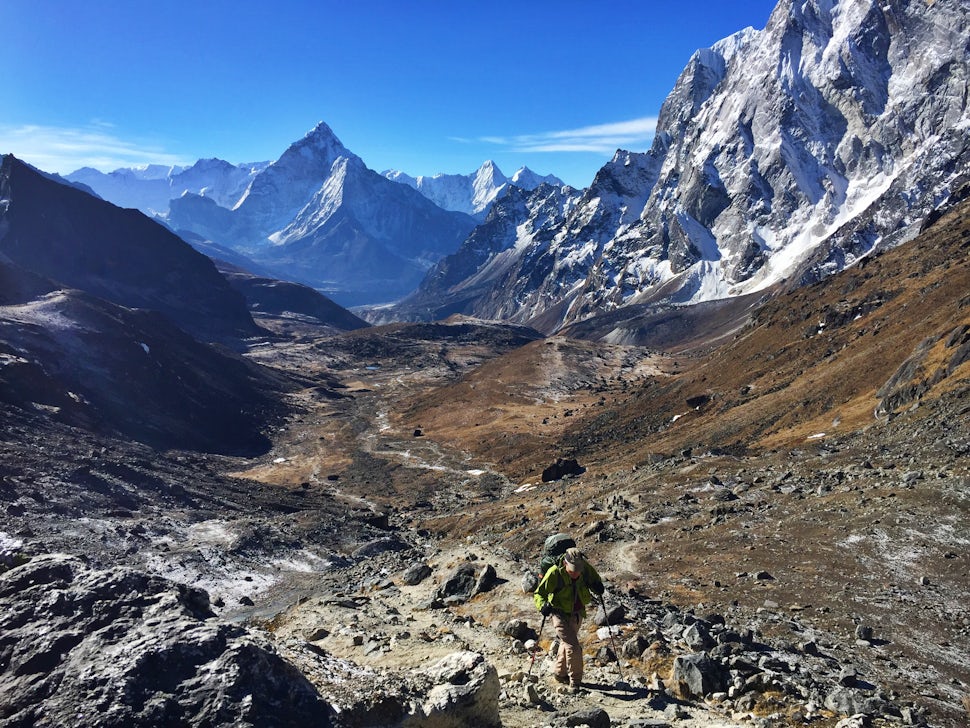The Ultimate Guide to Trekking in Nepal
Find the perfect trek for your fitness level, your timeline, and your priorities in the heart of the Himalayas.

As the weather warms and melts away winter snow, the most wonderful time of the year rapidly approaches: Nepal trekking season. Spring (February - May) is one of the most popular times to visit this high-altitude countryside for ideal hiking and climbing conditions, while Autumn (September - December) offers crystal-clear views of the world's highest peaks.
Nepal boasts some of the highest trekking traffic in the world because it has every type of trail, from beginner to advanced. All of the treks below rely on overnighting in teahouses, where no camping or cooking is required - which (literally) takes a huge weight off of your shoulders. Plus, every trek in Nepal is unique; from views and length, to location and difficulty.
With so many options, it’s important to think about which choice is right for your fitness level, your timeline, and your priorities. Check out each of the following Nepal treks below to find your perfect fit.
Annapurna Circuit Trek
Overview: 145 miles + 15,000 ft. of elevation gain
Trail Type: Loop
Length: 12-18 days
The highs:
- Widely considered to be one of the best treks in the entire world.
- Flexibility: Two-thirds through the circuit, trekkers have bus options to shorten or lengthen their trip as they please.
- There are nicer amenities in many of the towns along this route, which means that you’ll probably have the option to splurge on a hot shower if you choose to do so.
The lows:
- Very popular and often crowded during high season, though this can also be a great way to meet fellow travelers.

Annapurna Sanctuary + Base Camp Trek
Overview: 50 miles + 13,450 ft. of elevation gain
Trail Type: Out-and-back
Length: 7-10 days
The highs:
- Less crowds, less time, with comparable views to the Annapurna Circuit Trek.
- Get up close and personal with the 10th tallest mountain in the world.
- Begins and ends out of Pokhara, a charming lakeside town where you'll find post-trek rewards like endless restaurant and bar options, kayaking and canoeing, and world-class paragliding.
The lows:
- This is a very tough trek, made even more difficult by the altitude, cold temperatures, and weather. While most other treks can be accessed year-round, snow and avalanches block off access to ABC through early spring.

Gokyo Trek
Overview: 33 miles + 6,300 ft. of elevation gain
Trail Type: Out-and-back
Length: 6-8 days
The highs:
- Those brilliant turquoise lakes you see on Nepal Trekking books and websites? Yep, those are the world-famous Gokyo Lakes, and this trek takes you to the center of them.
- It’s high, but not too high. Gokyo has just enough amenities to make sleeping above 15,000 ft. comfortable.
- Opportunity to summit Gokyo Ri (17,585 ft.).
The lows:
- For the price you pay to travel to the Khumbu region, it would be really worthwhile to explore more to the east and center of the valley, including Everest Base Camp.

Everest Base Camp Trek
Overview: 38.5 miles + 9,025 feet of elevation gain
Trail Type: Out-and-back
Length: 12-14 days
The highs:
- Most direct route to see the world-famous Everest Base Camp. Plus, the opportunity to meet high-altitude Himalayan climbers along the way.
- Plenty of guide and porter support along the way, should you choose to hire help.
- Opportunity to climb Kala Patthar (18,514 ft.).
The lows:
- One of the most expensive trekking regions in Nepal.

Three Passes Everest Base Camp Trek
Overview: 110 miles + 20,800 ft. of elevation gain
Trail Type: Loop
Length: 18-22 days
The highs:
- Because this is the most difficult of all of these treks, it is also considered by many to be the most rewarding.
- Combines 3 popular treks into one long circuit, so you truly see as much as possible of the Khumbu Valley.
- Opportunity to climb three major trekking peaks, including Chukkung Ri, Gokyo Ri, and Kala Patthar.
The lows:
- Extremely long days, strenuous terrain, and high altitudes – not for the faint of heart.

Ghorepani - Ghandruk Loop Trek
Overview: 4,150 ft. of elevation gain
Trail type: Loop
Length: 3-5 day
The highs:
- Ghorepani region is home to the famous blooming rhododendrons, the national flower of Nepal.
- Chance to climb Poon Hill, one of the most popular and most staggeringly beautiful sunrise spots in the Annapurna region.
- Great option for those with a shorter timeline.
The lows:
- Farther removed from the “big” mountains and true high-elevation Himalayan experience, this trail stays at a relatively low altitude.

Langtang Valley Trek
Overview: 75 miles + 7,766 ft. of elevation gain
Trail Type: Out-and-back
Length: 5-7 days
The highs:
- Jaw-dropping glacial valley experience at a relatively low altitude, which makes this route accessible in the winter. Plus: you’re less likely to experience symptoms of AMS.
- Turn around at any time; the entire region makes for a worthwhile visit whether you stop at Langtang Village or go all the way to Kyanjin Gompa.
- Every rupee you spend here benefits the local families who are recovering from the 2015 earthquake.
The lows:
- Limited lodging and restaurant options following the quake, though that shouldn’t stop you. Here’s why.

No matter which trek you choose, you truly can't go wrong. Visit Nepal and see what all the (high altitude) hype is about.
We want to acknowledge and thank the past, present, and future generations of all Native Nations and Indigenous Peoples whose ancestral lands we travel, explore, and play on. Always practice Leave No Trace ethics on your adventures and follow local regulations. Please explore responsibly!
Do you love the outdoors?
Yep, us too. That's why we send you the best local adventures, stories, and expert advice, right to your inbox.









